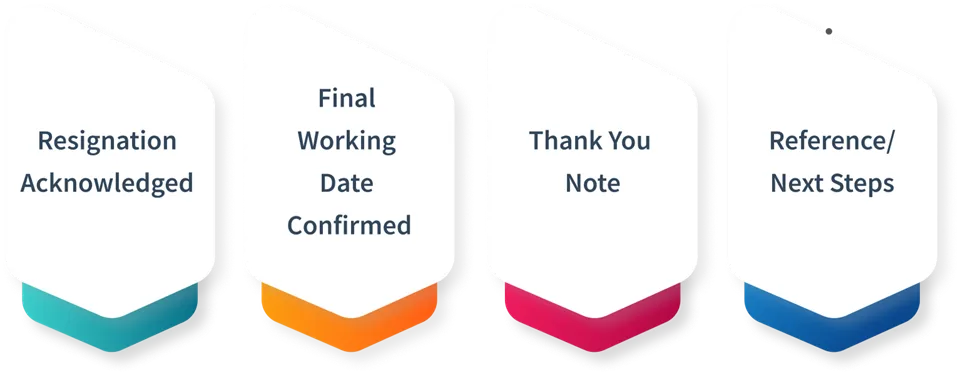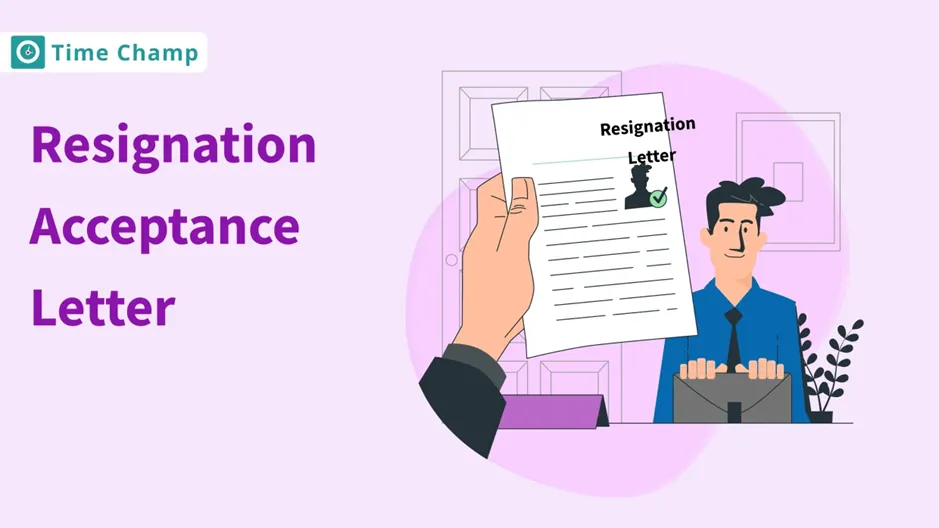A resignation acceptance letter is needed to confirm that an employee is leaving the company. A well-written and professional resignation acceptance letter from HR managers and employers helps keep things clear, maintains good relationships and makes the process of leaving smoothly.
Using the correct template allows the company to look professional and ensures that details about the employee’s departure, future notice and any following steps.
In this blog, you can use over 10 resignation acceptance letters and email templates made for different situations, and you will also find expert advice on the best ways to write and format your acceptance letter. To align with the latest trends, all content is updated according to 2025’s HR standards and best practices, turning it into a broad resource for employees.
What is a Resignation Acceptance Letter?
An employer issues a Resignation Acceptance Letter to confirm and accept when an employee resigns. It explains when the last day is, when notice has to be given, and what tasks are required for handing over. It not only helps the exit to be smooth and professional but also provides HR and payroll with accurate, formal records for processing.
Why Is a Resignation Acceptance Letter Important?
A Resignation Acceptance Letter is not merely a paperwork. It's an essential part of the offboarding process for employees. It gives formal recognition to an employee's resignation, avoiding any legal or HR misunderstandings. It spells out the acceptance, the last working date, and outstanding commitments, safeguarding both the company and the exiting employee. Above all, it serves as a dignified and professional end, keeping the door open for possible future collaboration or re-employment.
What to Include in a Resignation Acceptance Letter
During the offboarding process, professionalism and clarity are guaranteed by a well-written resignation acceptance letter. Maintaining openness and goodwill between the employer and employee is provided by including the certain things.

Acknowledgement of Resignation
Begin by stating clearly that you have received and accepted the resignation. Mention the name, title, and date of the employee's resignation. This establishes a formal tone and validates understanding on both sides.
Last Working Day
Mention the employee's last date of work following the agreement or notice period. By doing this, misunderstandings are avoided, and both sides agree regarding transition schedules and handovers.
Expression of Gratitude
Thank the employee for their time with the organization. A genuine word of appreciation, irrespective of the reason for leaving, sustains positive relationships and makes a favourable impression.
Optional Reference Offer or Further Instructions
Additionally, you can also add that you are willing to serve as a reference or mention the remaining steps., e.g., full and final settlement, return of company property, or exit interviews. This provides closure and understanding.
How to Format a Resignation Acceptance Email
When you send a well-formatted acceptance email for your resignation, your message will be clear, polite and professional. Here's how to lay it out for optimal readability and efficiency:
Subject Line Tips
Use a simple and professional subject line. Be sure to add the employee’s name and what the email is about.
Examples:
- Resignation Acceptance – [Employee Name]
- Confirmation of Resignation – [Employee Name]
- Acknowledgement of Resignation Letter
Opening Sentence Examples
Start the email by stating that you have received the letter or email and acknowledging the resignation.
Examples:
- “We acknowledge receipt of your resignation letter dated [date]...”
- "Your decision to resign from the position of [Job Title] is accepted from [last working day]...”
- "This is to accept your resignation dated [date]…"
Body Structure
- A message to express gratitude for what they have done.
- Notice of the last working day.
- Optional details such as how to exit the contract, the final settlement or the return of company property.
- Make your paragraphs brief and use a professional tone.
Closing Statements
End your email positively to keep a friendly relationship.
Examples:
- “We hope you achieve further success in everything you do.”
- “I appreciate all the work you do for [Company Name].”
- “You can get in touch with us any time you need help during your transition.”
10+ Resignation Acceptance Letter/Email Templates
Each resignation situation calls for a slightly different format and tone. HR professionals and managers can modify the ready-to-use resignation acceptance letter/email templates below according to the circumstances. These samples are up to date for 2025 and adhere to professional standards.
General Acceptance Letter
A simple template that can be used in many resignation scenarios and does not specify the reason for resignation.
Subject: Acceptance of Resignation Letter
Dear [Employee’s Name],
This is to formally acknowledge and accept your resignation dated [Resignation Date], effective from [Last Working Day].
We appreciate your contributions during your tenure at [Company Name] and thank you for your efforts and professionalism. It has been a pleasure working with you, and we wish you all the best in your future endeavours.
Please ensure all necessary handover procedures are completed before your departure.
Sincerely,
[Your Name]
[Your Designation]
[Company Name]
For Personal Reasons
When an employee leaves because of personal obligations or family issues, use this.
Subject: Resignation Acknowledgement – [Employee’s Name]
Dear [Employee’s Name],
I acknowledge receipt of your resignation letter dated [Resignation Date], stating your intention to resign due to personal reasons, with your last working day being [Last Working Day].
While we are sorry to see you leave, we respect your decision and appreciate the work you’ve done during your time with [Company Name]. We wish you the very best as you focus on your personal priorities.
Please ensure the handover process is completed as per HR protocol.
Best regards,
[Your Name]
[Your Designation]
[Company Name]
For Better Opportunity/Career Growth
Acknowledge the career change while maintaining an encouraging and supportive tone.
Subject: Acceptance of Resignation – [Employee’s Name]
Dear [Employee’s Name],
I acknowledge receipt of your resignation letter dated [Resignation Date], stating your intention to resign due to personal reasons, with your last working day being [Last Working Day].
This is to formally acknowledge and accept your resignation letter submitted on [Resignation Date], with your final working day being [Last Working Day].
We understand your decision to pursue a better opportunity for career advancement and respect your aspirations. Thank you for your valuable contributions to [Company Name] during your tenure.
We wish you continued success in your future endeavors. Please coordinate with your manager and HR team to complete the exit process smoothly.
Warm regards,
[Your Name]
[Your Designation]
[Company Name]
For Higher Studies
Ideal for workers who want to continue their education. Show appreciation and support for upskilling.
Subject: Resignation Acceptance – [Employee’s Name]
Dear [Employee’s Name],
This letter is to formally acknowledge and accept your resignation dated [Resignation Date], with your last working day being [Last Working Day].
We appreciate your decision to pursue higher education and commend your commitment to personal and professional growth. Your contributions to [Company Name] have been valued, and we thank you for your dedication during your time here.
We wish you all the best in your academic journey and future endeavors. Please ensure all exit formalities are completed as per the HR process.
Best regards,
[Your Name]
[Your Designation]
[Company Name]
Due to Relocation
When an employee is moving to a different city or nation, use this template.
Subject: Resignation Acceptance – [Employee’s Name]
Dear [Employee’s Name],
We acknowledge and accept your resignation effective from [Last Working Day], as submitted on [Resignation Date].
We understand that your decision to resign is due to your relocation, and while we are sad to see you go, we fully support your move. Your efforts and contributions to [Company Name] have been truly appreciated.
We wish you success in your new journey and thank you for the professionalism you've shown throughout your tenure.
Best regards,
[Your Name]
[Your Designation]
[Company Name]
Due to Health Reasons
Acknowledge the resignation formally while staying sympathetic and understanding.
Subject: Acceptance of Resignation – [Employee’s Name]
Dear [Employee’s Name],
We have received and accept your resignation, effective from [Last Working Day], as mentioned in your letter dated [Resignation Date].
We understand that your decision stems from health-related concerns. While we are saddened to see you leave, we fully respect your need to prioritize your well-being.
Thank you for your valuable contributions during your time with us. We wish you a smooth recovery and all the best for the future.
Sincerely,
[Your Name]
[Your Designation]
[Company Name]
Due to Retirement
Honour enduring contributions and express gratitude for the retiree's service.
Subject: Acceptance of Retirement Resignation – [Employee’s Name]
Dear [Employee’s Name],
We acknowledge receipt and acceptance of your resignation due to retirement, effective from [Last Working Day], as per your letter dated [Resignation Date].
We sincerely thank you for your dedicated service and valuable contributions over the years. Your commitment and professionalism have been truly appreciated.
We wish you a fulfilling and joyful retirement ahead. Please stay in touch, and best wishes for this new chapter in your life.
Sincerely,
[Your Name]
[Your Designation]
[Company Name]
For Internal Transfer
When an employee changes departments or roles within the same company, use this.
Subject: Acceptance of Resignation for Internal Transfer – [Employee’s Name]
Dear [Employee’s Name],
We acknowledge receipt and acceptance of your resignation due to retirement, effective from [Last Working Day], as per your letter dated [Resignation Date].
We sincerely thank you for your dedicated service and valuable contributions over the years. Your commitment and professionalism have been truly appreciated.
We wish you a fulfilling and joyful retirement ahead. Please stay in touch, and best wishes for this new chapter in your life.
Sincerely,
[Your Name]
[Your Designation]
[Company Name]
For Poor Performance/Termination
Remain neutral and factual. Refrain from using accusatory language and acknowledge the resignation.
Subject: Acceptance of Resignation – [Employee’s Name]
Dear [Employee’s Name],
This letter acknowledges receipt and acceptance of your resignation from your position at [Company Name], effective [Last Working Day].
organization, we appreciate the efforts you made during your time here. We wish you success in your future endeavors.
Please ensure that all company property is returned and any pending tasks are handed over before your departure.
Sincerely,
[Your Name]
[Your Designation]
[Company Name]
For Resignation during Probation
Brief and official, with an emphasis on duties completed and next steps.
Subject: Resignation Acceptance – [Employee’s Name]
Dear [Employee’s Name],
We acknowledge and accept your resignation dated [Resignation Date] from the position of [Job Title], effective [Last Working Day].
As you were serving your probationary period, we appreciate your decision to move forward and respect your choice. We thank you for your contributions during this brief period and wish you the best in your future career.
Please ensure the return of any company property and complete all formalities before your final day.
Sincerely,
[Your Name]
[Your Designation]
[Company Name]
After Maternity or Paternity Leave
Maintain a professional demeanour while showing empathy and respect for individual choices.
Subject: Acceptance of Resignation – [Employee’s Name]
Dear [Employee’s Name],
We acknowledge your resignation dated [Resignation Date] and accept your decision to step down from your position as [Job Title], effective [Last Working Day].
We understand that your decision follows your recent maternity/paternity leave, and we respect your choice to prioritize your personal commitments. We appreciate the dedication and contributions you have made during your tenure with us.
Please ensure all necessary exit procedures are completed before your final working day. We wish you and your family the very best for the future.
Warm regards,
[Your Name]
[Your Designation]
[Company Name]
Expert Tips for Writing a Professional Resignation Acceptance
A resignation acceptance letter should be both respectful and professional, acknowledging the employee’s decision with understanding and clarity. The following are key points to help your message remain clear, respectful, and purposeful:
Keep Tone Neutral and Respectful
A resignation acceptance letter should be both respectful and professional, acknowledging the employee’s decision with understanding and clarity. Keep a neutral, respectful tone no matter the reason for leaving. This helps the relationship remain professional and respectful.
Avoid Emotional Language
Avoid using personal opinions, feelings, or sensational phrases. Speak clearly and remain factual to help avoid misunderstandings and show that you are professional.
Customise the Message for the Reason
Adapt your response according to the reason for resignation, can be personal reasons, moving locations, retirement, or medical issues. A personalized touch demonstrates consideration and brings clarity.
Proofread for Tone and Clarity
Before posting, proofread the letter's tone of voice, grammar, and readability. Make sure that the language is professional and the intention is clear.
Final Thoughts
A compelling resignation acceptance letter is essential during the offboarding process and reflects your company's respect for the employee. Recognizing a resignation properly preserves positive employer branding and legal clarity, regardless of the reason whether personal, career advancement, or retirement.
Managers and HR specialists can react swiftly and correctly to any resignation situation by utilising the appropriate format, tone, and templates offered in this blog. Keep your approach polite and in line with your company's values, proofread for clarity, and modify each message according to the context.
To keep your HR communication modern and efficient, stay up to date in 2025 best practices and standards.
Frequently Asked Questions
You should send the email within 24-48 hours of receiving the resignation to show timeliness and professionalism. Timely communication demonstrates respect for the employee’s decision and provides clarity, allowing both sides to plan the transition effectively.
Yes, mentioning the notice period and confirming their last working day ensures clarity for both parties. This avoids potential misunderstandings and sets expectations for the remainder of their tenure. It’s a key detail that helps with smooth planning and handovers.
No, resignations are typically a personal decision, and it’s inappropriate to decline them. However, if you wish to discuss their decision further, you can express your openness to a conversation before sending a formal acceptance. This shows respect while leaving room for dialogue.
No, counteroffers should be addressed separately, preferably in a discussion before accepting their resignation. Once you’ve sent the acceptance email, it signals finality, so counteroffers would seem out of place or contradictory at that stage.
Yes, if the departure is helpful, mentioning potential future opportunities is a great way to maintain a positive relationship. Letting them know they are welcome to return can leave a lasting impression and foster goodwill.
Here are Some Related Articles You may Find Interesting

What is the Average Salary in Bangladesh: Overview & Insights
Discover The Average Salary in Bangladesh and outsourcing impact. Learn why it’s a rising player in global outsourcing.

Average Salary in India: Factors and Comprehensive Comparison
Discover the key factors influencing the average salary in India across industries, regions, and job levels, as well as insights.

What is the Average Salary in Colombia? & Factors Affecting
Discover the average salary in Colombia and explore the key factors affecting earnings, including industries, experience, and location. Find out.

What is the Average Salary in Indonesia?
Discover the average salary in South Africa and explore outsourcing trends. Learn key insights into wages, industries, and business opportunities.

What is the Average Salary in Hong Kong? and It’s Statistics
Learn about the average salary in Hong Kong, from minimum wage to maximum salaries, and gain insights into industry variations.

What is the Average Salary in Singapore: Economic Outlook
Discover the average salary in Singapore, key factors affecting income, insights into the nation’s economic outlook & explore its trends.



